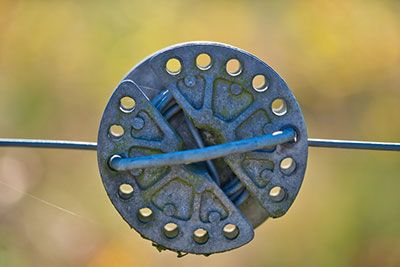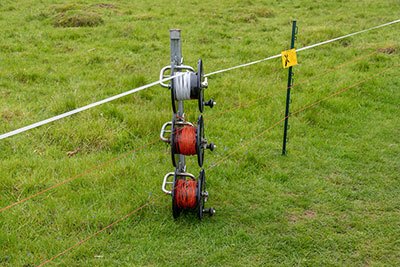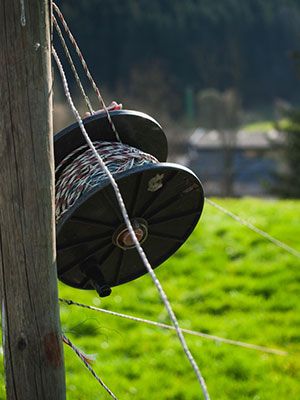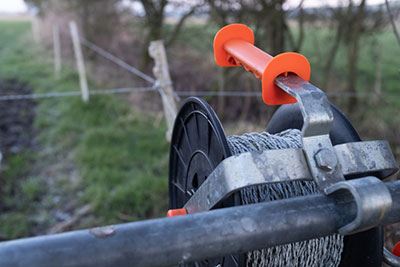Electronic fencing has come a long way since it was first introduced.
In this post, we’ll discuss what electric fence polywire is, how to choose the right type for your needs, and all the other benefits you must know.
Whether you’re an experienced farmer or just getting started with fencing your land, you’ll know why electric fence poly wire may be just what you need to keep livestock safely enclosed on your farm!
Take away key points:
- Poly wires are known for good conductivity, and causing a stronger shock to intruders
- They suit electric fences and are easy to set
- You must maintain them regularly for the best conductivity message to prevent predators from entering your properties
Table of Contents
Poly wire for the best electric fence wire
There are multiple requirements for electric fencing needs, to ensure the best electric fence standards and protect your property. So, read our guide below to see how the poly wire can help you in this process.
What is poly wire in the electric fencing system?

Poly wire is a type of electric fencing system that uses narrow braids made up of metal wires and non-conducting plastic threads. This type of electric fence is ideal for controlling stock movement, excluding wildlife and livestock from crops, orchards, and gardens, and can be cut to the desired length.
Poly wire is also highly visible due to its ultra-white color, making it easier to monitor animal control. Additionally, poly wire requires less power than other types of electric fencing systems, making it more efficient and cost-effective.
What is the purpose of the electric fence polywire?
This electric fence wire is made up of multiple strands of stainless steel wire, which are insulated with a plastic coating. This type of fence line is designed to provide an effective barrier against animals and other intruders. The electric fence wire also provides safe and reliable conductivity for the electric current running through it.
Additionally, the electric fence line is lightweight, easy to install, repair, and splice, making it ideal for both permanent and temporary fencing applications. Its UV-resistant properties make it the best option for use in outdoor environments.
What are the different electric fence wire types?
The most common types of electric fencing are: poly wire, poly rope, and poly tape.
The poly wire consists of narrow braids made up of metal wires and non-conducting plastic threads. It is lightweight, easy to use, and highly visible.
Poly rope is similar to the poly wire but thicker in diameter and more durable. It also has a higher breaking strength than poly wire, making it ideal for heavier livestock or larger areas.
Lastly, the poly tape is the widest type of electric fence wire and has the highest breaking strength. It can be used for both permanent and temporary electric fencing needs and is highly visible due to its reflective properties.
How to choose the best poly wire for electric fencing needs?
It is essential to inspect the characteristics of poly wire, ropes, braids, and poly tapes before purchasing them. Poly wire and tapes have varying degrees of quality and electrical properties.
Purchase them from reputable suppliers or manufacturers to ensure quality materials and proper UV treatment. Generally, the price of the tools can be an indicator of their quality.
Here are other things to consider for the best fencing element types and your livestock protection:
1. The origin of the desired fencing products
Produce your products in Australia as they are designed for local conditions and generally have a higher quality. This also contributes to job opportunities in the manufacturing and agricultural industries, among others. Find Australian-made and owned products or reputable brands that comply with Australian and New Zealand standards and provide good quality products.
Be cautious when purchasing poly wires, braids, ropes, and tapes from platforms like eBay, Amazon, and other sites. Although the price may be appealing, these products are usually of poor quality and don’t meet basic standards, such as UV treatment for plastics. They tend to last only for short periods.
2. Quality factors

When choosing a product, there are various quality factors to consider. Here are some examples:
Metal strands and fibers
The thickness and number of wires are significant and will influence the cost of the product. There are two primary metal configurations in the market:
– Pure stainless steel wires: less conductive compared to other metals but mechanically stronger
– Mixed metal strand wires (tinned copper wires): deteriorate when overworked (such as in strip grazing) with a short lifespan. They provide less resistance and keep the high electric fence shock running for longer distances.
Manufacturing
Check the brand and manufacturing of the product.
Construction
Inspect the poly wire or tape weave for neatness. The elements should be tightly bound or woven. Loose-wound or woven poly products, typically found in cheap imported products, can fall apart quickly.
U.V. treatment
Ensure that the poly product is U.V. treated to prevent breaking down under ultraviolet radiation or sunshine. This is often the cause of electric fence failure and breakages.
3. Conductivity and Ohms current measurements
Look at the Ohms or resistance values of the products. This value indicates how far the fence will be useful. The less resistance of the fencing, the better it works.
For example, a line with 10 Ohms is better than 100 Ohms. Ohms is the measure of hot wire resistance, dictating the amount of electricity contentment transmitted through the electric fence.
In electric fencing, the fewer metal wires the fence has, the less electricity can flow through it. The less distance it can flow on your fence before running out of zap. For longer electrified fencing or achieving a full shock over the entire distance, find products with low resistance values.
Other issues can also shorten the electricity flow and conductivity on your fence. Voltage leaks from branches, grass, or fallen posts can earth out the hot wires, which causes electricity conductivity to leak out of the fence and into the ground.
To avoid this, a regular fence check should be carried out at least once a week, depending on the growth rates and decay of the local plant life. Wire breakages should be repaired immediately, and connections should be sturdy, complete, and free from arcing or sparking. The best choice is to use connection bolts.
4. Choosing the best color for the fence
Poly wires and poly tapes are available in a wide range of colors, from white to black, and every color in between. Consider the surrounding environment and how visible you need the fence to be to decide the best choice for your lawn.
For instance, dogs and other pets are smart and don’t require much visual reminder of the fence location. So choose units that suit the backyard surroundings.
On the other hand, horses are fast and sometimes erratic, so a highly visible tape, braid, or rope is recommended. They stand out from the surrounding backdrop so horses can distinguish them better than other pets and animals.
White is the best color for most cases because of its high visibility. Colors like orange and red are preferred for snowy, lighter areas. Certain animals such as horses can see some colors better than others.
For example, horses are known to see yellows and blues better than other colors. This way you can easily adjust the overall fencing form and keep your animals protected.

5. The thickness of the fencing products
Thick poly ropes and tapes are generally safer and more visible than thinner products, such as a poly wire. These thicker elements offer great visual reinforcement, but they tend to catch more weather. They may result in increased wear and tear in lawn areas with strong winds and UV damage in sunny lawn regions. To minimize the wind’s effect, use smooth-edged electric fence insulators and space fence posts closer together in windy areas.
Although thicker is typically better, consider the stock and the containment or exclusion zone’s importance, local weather conditions, overall electric fencing budget since the wire or tape can be a significant portion of the fence’s overall cost.
If you live in a windy area and have horse electric fence boundaries, you may need to use highly visible poly ropes or braids or replace the poly tapes at regular intervals. Don’t use a thin wire or in this case, even though it lasts longer than a thicker tape, as it is less effective as a visual reminder and injury-preventative tool.
Different cases require different levels of visibility, resistance, and value for money. Thinner poly ropes, braids, and wires work best in areas where visibility is not critical, (pet containment electric fences), or areas where they need to be moved around frequently (strip grazing). These products usually have fewer conductive wires, making them fine for shorter electric fence runs.
Proper poly wire maintenance
To ensure optimal electric fence maintenance, you should check the fence regularly for signs of damage or wear and tear. Look for loose wires, broken posts, and other areas where the fence may need repair.
Additionally, make sure that weeds and grass are trimmed away from the bottom strand of the fence so they don’t interfere with its operation. You should also check the voltage levels of your electric fence to make sure it is providing enough power to deter animals or intruders.
Consider investing in a strong charger for your electric fence so that it can provide consistent power over long periods. This will help reduce the number of repairs you have to do on your fence and will help keep it functioning properly for years to come.
FAQs
How long does poly electric fence wire last?
It lasts up to 10 years of outdoor use.
How do you end an electric poly wire fence?
You can use a fence end post with an insulator. This post has a hole for the wire to pass through and an insulator that prevents electricity from passing through it.
How to connect a poly wire electric fence?

Follow the steps below:
– Connect one end of the poly wire to the ground rods using clamps or by winding the filaments around the poly wire and making a knot.
– Attach the other end of the wire to an energizer, which will provide power to your fence.
– Check for any breaks in the wire and make sure it’s properly insulated before turning on the power.
How to splice poly wire electric fence?
Follow the three methods below:
– Burn the ends of the poly wire and tie a knot further down the line
– Tie both ends of the break in your electric fence wire or tape them together as securely as possible
– Use three crimping sleeves and some electrical tape.
Summary
A polywire is a great way for added protection of animals for a number of reasons. So you can place it over your fencing and it will work well to keep your livestock safe for an extended time.
